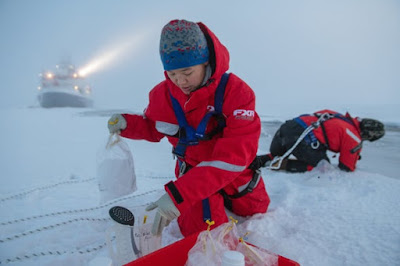 |
| MOSAiC researchers take samples on the ice near the Polarstern. Credit: Esther Horvath Alfred-Wegener-Institut (CC-BY 4.0) |
Topics: Climate Change, Existentialism, Global Warming, Research
The first leg of an ambitious, yearlong Arctic science expedition just ended, and scientists say they’ve already gained new insight into the rapidly changing Arctic—the fastest warming region on Earth.
An initial team of researchers from the MOSAiC Expedition—short for Multidisciplinary Drifting Observatory for the Study of Arctic Climate—arrived in the port city of Tromsø, Norway, on New Year’s Day after more than three months at sea. Billed as the largest Arctic science mission in history, the expedition launched from the same spot on Sept. 20, led by a German icebreaker known as the Polarstern.
The Polarstern remains in the central Arctic Ocean, now staffed by a replacement research team. The mission’s goal is to spend a year closely observing the fine details of the Arctic climate system, including the interactions among the ocean, sea ice and atmosphere.
To accomplish that goal, the Polarstern has allowed itself to freeze into the sea ice in the central Arctic Ocean, where it will remain stuck in place as it drifts across the top of the world. The ship is expected to emerge next fall somewhere north of Greenland, with a year’s worth of continuous scientific data under its belt.
Researchers are optimistic the mission will provide an unprecedented perspective on the shifting Arctic, where the effects of climate change are unfolding at a dramatic pace.
I'm not sure John on the island of Patmos had the above in mind.
Then I saw "a new heaven and a new earth," for the first heaven and the first earth had passed away, and there was no longer any sea. Revelation 21:1
Frozen in Dwindling Ice, a Historic Expedition Finds a “New Arctic”, Chelsea Harvey, Scientific American
Comments